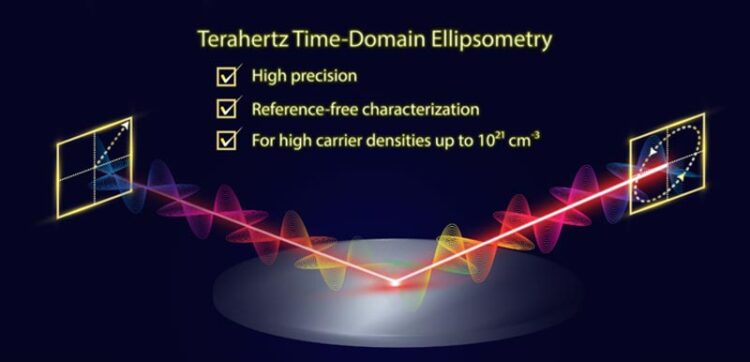Development of high-precision THz time-domain ellipsometry for wide-gap semiconductors

Schematic image of Terahertz time domain ellipsometry
Credit: Osaka University
In semiconductor device applications, there is an increasing demand for semiconductors with very high carrier concentrations. The semiconductor material parameters, namely carrier density and mobility, are what primarily determine device performance. Hence, it is important to accurately characterize the carrier density and mobility of a semiconductor for the development of its device applications.
The use of THz waves, or electromagnetic radiation with wavelengths of around 300 µm and frequency of about 1 THz, in the nondestructive testing of semiconductors has been continuously expanding. Free carriers in a material absorb THz radiation, which makes it possible to estimate the electrical properties of semiconductors using THz waves.
Researchers at Osaka University, in collaboration with Nippo Precision Co., Ltd., developed a THz time-domain ellipsometry system (Tera Evaluator®) that extends the range of carrier concentrations measurable by THz waves up to ~1020 cm-3 and potentially higher by improving the precision of said optical technique. In THz time-domain ellipsometry, linearly polarized THz pulses are incident on a sample and the electric field strength of the reflected THz waves as a function of time is measured. Specifically, the reflected waves polarized in the direction parallel (p) and perpendicular (s) to the plane of incidence are of interest. The ratio of the p– and s– polarization components yields information on the electric permittivity of the sample, allowing for the evaluation of the carrier density and mobility. As such, unlike THz time-domain spectroscopy, THz time-domain ellipsometry does not require reference measurements through an aperture or standard mirror. Tera Evaluator® employs a polarizer-sample-rotating analyzer optical configuration, wherein the analyzer angular orientation is varied from 0° to 360° in 15° increments. This multi-angle technique is used to eliminate the systematic errors from the amplitude and phase of the detected THz electric field in the analysis, which is newly employed in THz time-domain ellipsometry. This novel correction method improves the precision of THz time-domain ellipsometry by over ten times. Consequently, the maximum carrier concentration that can be evaluated is over 2 orders of magnitude higher than usually reported using other THz time-domain techniques.
As a demonstration, the researchers evaluated the gallium nitride (GaN) wide-gap semiconductor, which is one of the most technologically important semiconductors present in various power electronics as well as 5G devices. GaN is also the leading candidate material for future 6G devices operating beyond 100 GHz. In a Scientific Reports publication, they show that the high-precision THz time-domain ellipsometry system is effective in the evaluation of carrier densities up to 1020–1021 cm-3 with superior accuracy and precision, which has been a challenge using THz waves, particularly at very high conductivities. The investigated GaN crystals were fabricated using a crystal growth method also developed at Osaka University called the point-seed technique via the Na-flux method, which produces high-quality GaN crystals.
The high-precision THz time-domain ellipsometry system is anticipated to be widely useful in the accurate, noninvasive characterization of various semiconductors with very high carrier concentrations.
The article, “Terahertz time-domain ellipsometry with high precision for the evaluation of GaN crystals with carrier densities up to 1020 cm-3,” is published in Scientific Reports at DOI: https://doi.org/10.1038/s41598-021-97253-z
About Osaka University
Osaka University was founded in 1931 as one of the seven imperial universities of Japan and is now one of Japan’s leading comprehensive universities with a broad disciplinary spectrum. This strength is coupled with a singular drive for innovation that extends throughout the scientific process, from fundamental research to the creation of applied technology with positive economic impacts. Its commitment to innovation has been recognized in Japan and around the world, being named Japan’s most innovative university in 2015 (Reuters 2015 Top 100) and one of the most innovative institutions in the world in 2017 (Innovative Universities and the Nature Index Innovation 2017). Now, Osaka University is leveraging its role as a Designated National University Corporation selected by the Ministry of Education, Culture, Sports, Science and Technology to contribute to innovation for human welfare, sustainable development of society, and social transformation.
Website: https://resou.osaka-u.ac.jp/en
Journal: Scientific Reports
DOI: 10.1038/s41598-021-97253-z
Method of Research: Experimental study
Subject of Research: Not applicable
Article Title: Terahertz time-domain ellipsometry with high precision for the evaluation of GaN crystals with carrier densities up to 1020 cm-3
Article Publication Date: 15-Sep-2021
Media Contact
Saori Obayashi
Osaka University
gi-strategy@cgin.osaka-u.ac.jp
Office: 81-661-055-886
Original Source
All latest news from the category: Physics and Astronomy
This area deals with the fundamental laws and building blocks of nature and how they interact, the properties and the behavior of matter, and research into space and time and their structures.
innovations-report provides in-depth reports and articles on subjects such as astrophysics, laser technologies, nuclear, quantum, particle and solid-state physics, nanotechnologies, planetary research and findings (Mars, Venus) and developments related to the Hubble Telescope.
Newest articles

Innovative 3D printed scaffolds offer new hope for bone healing
Researchers at the Institute for Bioengineering of Catalonia have developed novel 3D printed PLA-CaP scaffolds that promote blood vessel formation, ensuring better healing and regeneration of bone tissue. Bone is…

The surprising role of gut infection in Alzheimer’s disease
ASU- and Banner Alzheimer’s Institute-led study implicates link between a common virus and the disease, which travels from the gut to the brain and may be a target for antiviral…

Molecular gardening: New enzymes discovered for protein modification pruning
How deubiquitinases USP53 and USP54 cleave long polyubiquitin chains and how the former is linked to liver disease in children. Deubiquitinases (DUBs) are enzymes used by cells to trim protein…


